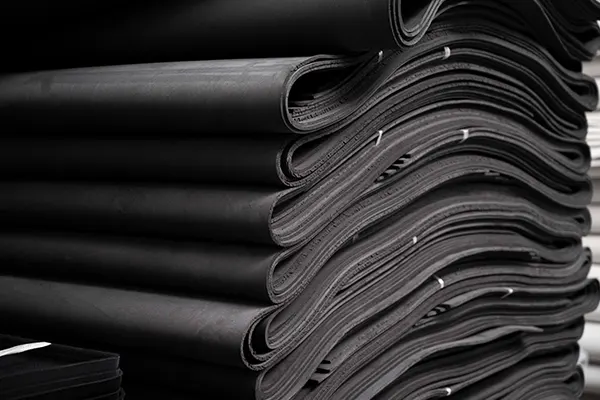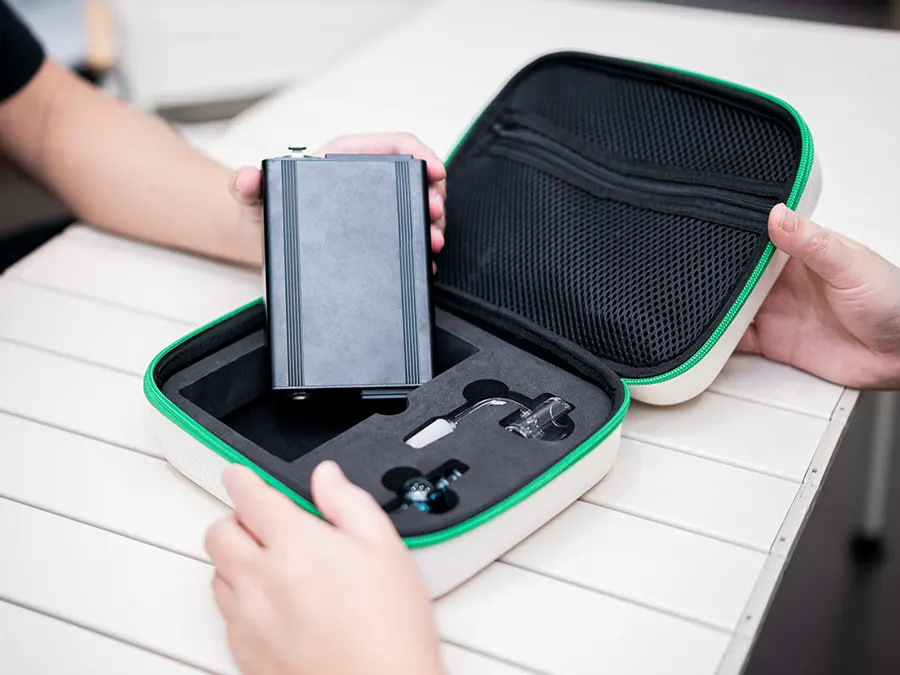La sélection du bon matériau pour votre projet ou produit est essentielle pour obtenir des résultats optimaux. L'EVA et le PVC sont deux matériaux couramment utilisés dans diverses industries en raison de leurs propriétés uniques et de leur polyvalence.. Dans ce guide complet, nous examinerons les caractéristiques de l'EVA et du PVC pour vous aider à prendre une décision éclairée sur celui qui convient le mieux à vos besoins spécifiques.. Regardons de plus près ce qui distingue ces matériaux.
Qu'est-ce que le matériau EVA?

Éthylène-acétate de vinyle (EVA) est un copolymère connu pour sa nature légère et flexible. Il est couramment utilisé dans la production de produits en mousse, comme les semelles de chaussures, équipement sportif, et matériaux d'emballage pour produire un étui EVA. L'EVA est également apprécié pour ses capacités d'absorption des chocs, ce qui en fait un choix idéal pour les équipements de protection et les applications de rembourrage.
Qu'est-ce que le matériau PVC?

Chlorure de polyvinyle (PVC) est un polymère plastique synthétique réputé pour sa durabilité et sa longévité. Le PVC est très polyvalent et peut être trouvé dans une large gamme de produits, y compris les tuyaux, cadres de fenêtres, sol, et signalisation. Ses propriétés résistantes à l'eau et ignifuges en font un choix populaire pour les applications extérieures et de construction..
Propriétés du matériau EVA

Léger et flexible
L'une des caractéristiques les plus remarquables de l'EVA est sa légèreté et sa flexibilité., ce qui le rend facile à travailler et confortable à porter. Cette qualité est particulièrement bénéfique dans les industries qui exigent que les produits soient légers mais durables., tels que les chaussures et les matériaux de rembourrage.
Capacités d'absorption des chocs
L'EVA est apprécié pour ses capacités exceptionnelles d'absorption des chocs, ce qui en fait un matériau idéal pour les produits résistants aux chocs comme les doublures de casque et les rembourrages de protection. Sa capacité à amortir et à absorber les forces d'impact contribue à réduire le risque de blessure dans les situations à fort impact.
Résistant aux intempéries
Un autre avantage de l’EVA réside dans ses propriétés de résistance aux intempéries, qui lui permettent de résister à l'exposition aux éléments sans se détériorer. Cela fait de l'EVA un choix fiable pour les applications extérieures où la durabilité et la longévité sont essentielles..
Inodore et non toxique
L'EVA est connu pour être inodore et non toxique, ce qui en fait un choix sûr pour les produits qui entrent en contact avec la peau ou les aliments. Sa nature non toxique le rend également respectueux de l'environnement, car il ne libère pas de produits chimiques nocifs dans l'environnement.
Propriétés du matériau PVC
Durable et durable
Le PVC est réputé pour sa durabilité et ses performances durables, ce qui en fait un choix populaire pour les produits qui nécessitent des niveaux élevés de résistance et de résilience. Sa capacité à résister à l’usure au fil du temps en fait une option rentable pour une utilisation à long terme.
Résistant à l'eau
L’un des principaux avantages du PVC réside dans sa résistance à l’eau., ce qui le rend parfaitement adapté aux applications où l'exposition à l'humidité est un problème. Le PVC n'absorbe pas l'eau, ce qui en fait un choix idéal pour les environnements extérieurs et marins.
Ignifuge
Le PVC est intrinsèquement ignifuge, ce qui signifie qu'il a une haute résistance à l'inflammation et ne propage pas facilement les flammes. Cela fait du PVC un matériau privilégié pour les applications où la sécurité incendie est une priorité., comme la construction de bâtiments et le câblage électrique.
Polyvalent dans les applications
Le PVC est très polyvalent et peut être adapté pour une utilisation dans un large éventail d'applications., de la tuyauterie et des cadres de fenêtres aux dispositifs médicaux et à la signalisation. Sa polyvalence et ses propriétés personnalisables en font un matériau incontournable pour diverses industries.
EVA contre. PVC, Quel est le meilleur?
En comparant l'EVA et le PVC, plusieurs facteurs clés entrent en jeu:
Poids et flexibilité
L'EVA est plus léger et plus flexible que le PVC, ce qui en fait un choix privilégié pour les applications qui nécessitent un toucher plus doux et un plus grand confort.
PVC, d'autre part, est plus robuste et moins souple, ce qui le rend mieux adapté aux structures rigides.
Durabilité et longévité
Le PVC est connu pour sa durabilité et ses performances durables, ce qui en fait un choix fiable pour les produits devant résister à une utilisation intensive et à des conditions difficiles.
EVA, bien qu'il ne soit pas aussi durable que le PVC, offre d'excellentes propriétés d'absorption des chocs et d'amortissement.
Résistance aux éléments météorologiques
L'EVA est résistant aux intempéries et peut résister à l'exposition aux éléments sans se détériorer, ce qui le rend adapté aux applications extérieures.
Le PVC est également résistant aux intempéries et peut résister à l'humidité et aux variations de température., ce qui en fait un choix fiable pour une utilisation en extérieur.
Tolérance à la chaleur et au froid
Le PVC a une tolérance plus élevée à la chaleur et au froid que l’EVA., ce qui le rend adapté aux applications nécessitant une stabilité thermique.
L'EVA peut ramollir ou durcir à des températures extrêmes, ce qui peut impacter ses performances dans certains environnements.
Comparaison des coûts
En termes de coût, L'EVA est généralement plus abordable que le PVC en raison de ses coûts de production inférieurs.. Cependant, La durabilité et la longévité du PVC peuvent compenser l’investissement initial, ce qui en fait un choix rentable à long terme pour certaines applications.
Applications dans les industries
L’EVA et le PVC trouvent un large éventail d’applications dans diverses industries:
Applications EVA
- Chaussure: L'EVA est un matériau populaire pour la fabrication de semelles et de semelles intérieures de chaussures en raison de ses propriétés légères et absorbant les chocs..
- Équipement sportif: L'EVA est utilisé dans la production de rembourrage sportif, casques, tapis, et poignées pour équipements sportifs.
- Équipement de protection: L'absorption supérieure des chocs de l'EVA en fait un matériau idéal pour créer des équipements de protection tels que des doublures de casque et des rembourrages pour les équipements de sport et de sécurité..
- Matériaux d'emballage: L'EVA est également utilisé dans la fabrication de matériaux d'emballage, y compris Étuis rigides en EVA pour l'électronique, outils, et articles délicats.
Applications PVC
- Tuyauterie: Les tuyaux en PVC sont largement utilisés en plomberie, irrigation, et systèmes de drainage pour leur durabilité, résistance à la corrosion, et facilité d'installation.
- Cadres de fenêtres: Le PVC est un matériau courant pour la fabrication de cadres et de profilés de fenêtres en raison de sa résistance aux intempéries., faibles besoins d'entretien, et efficacité énergétique.
- Sol: Revêtement de sol en PVC, y compris les carreaux de vinyle et les revêtements de sol en planches de vinyle, est populaire pour sa durabilité, résistance à l'eau, et une large gamme de modèles.
- Isolation électrique: Le PVC est utilisé dans les applications électriques pour l'isolation des câbles, câblage, et conduit électrique en raison de ses propriétés ignifuges et isolantes.
- Signalisation: Les feuilles et panneaux en PVC sont couramment utilisés pour la signalisation intérieure et extérieure en raison de leur durabilité., résistance aux intempéries, et facilité de personnalisation.
EVA contre. PVC, Lequel choisir?
Lorsque vous décidez entre l'EVA et le PVC pour votre projet ou produit, considérez les facteurs suivants:
- Si vous privilégiez la légèreté et la flexibilité, EVA pourrait être le meilleur choix.
- Pour les applications qui nécessitent durabilité et longévité, Le PVC peut être plus adapté.
- Résistance aux intempéries, tolérance à la chaleur, et les considérations de coût devraient également guider votre décision.
Conclusion
En conclusion, L'EVA et le PVC offrent des propriétés et des avantages uniques qui en font des matériaux précieux dans diverses industries. Comprendre les principales différences entre l'EVA et le PVC, comme le poids, flexibilité, durabilité, résistance aux intempéries, et le coût, vous aidera à prendre une décision éclairée sur le matériau le mieux adapté à vos besoins spécifiques. Que vous choisissiez l'EVA ou le PVC, les deux matériaux offrent une polyvalence, performance, et fiabilité pour une large gamme d'applications.
















